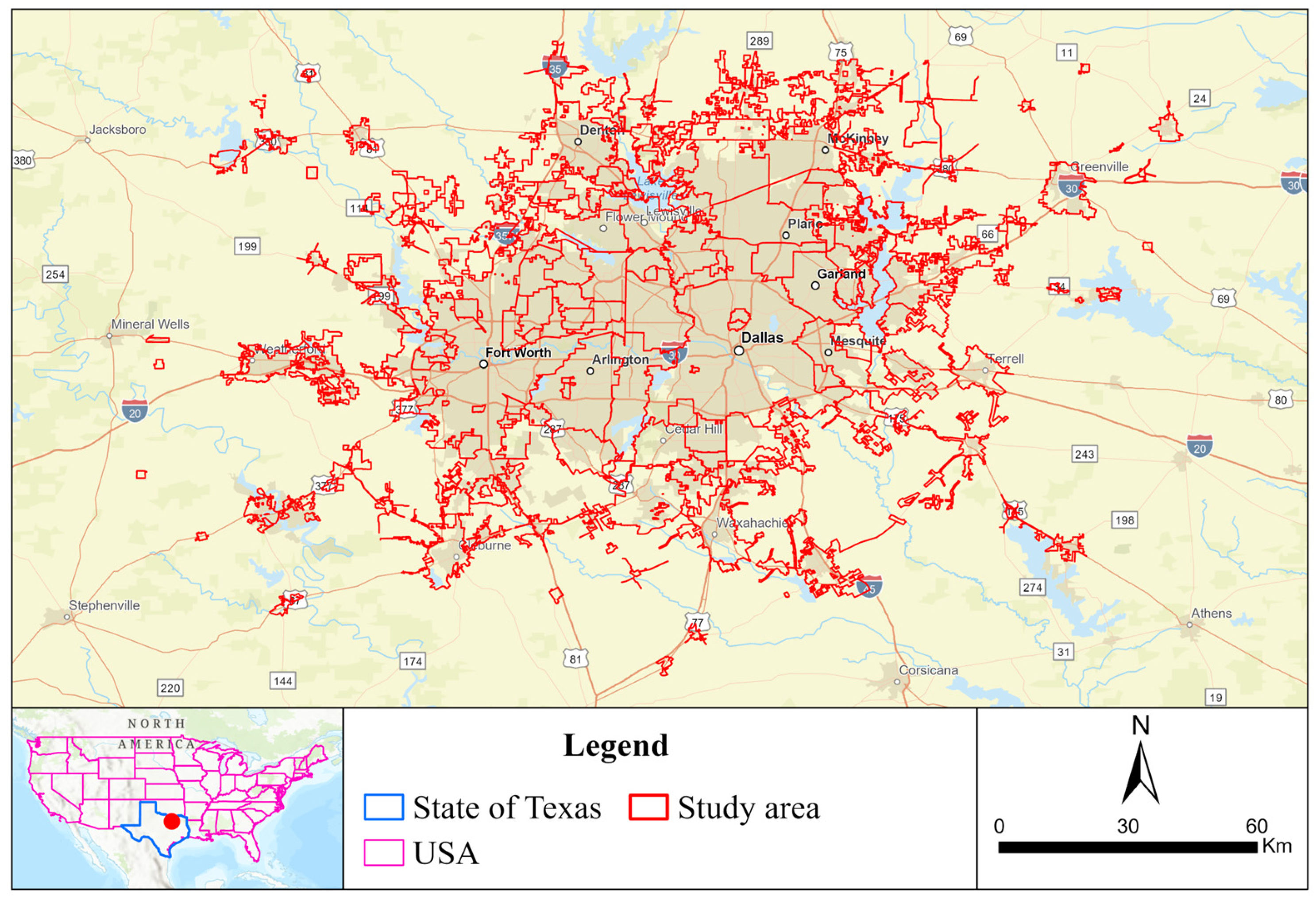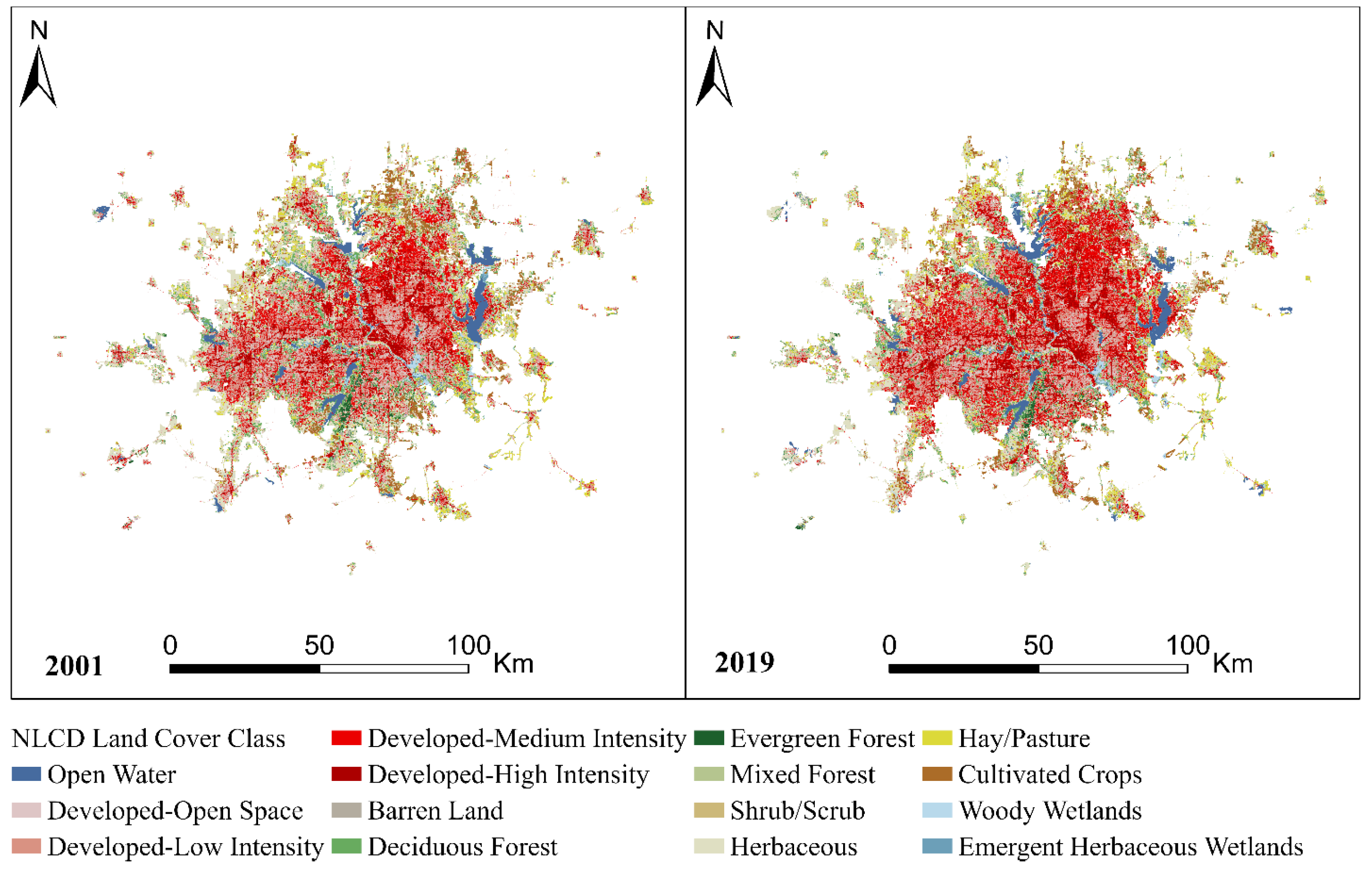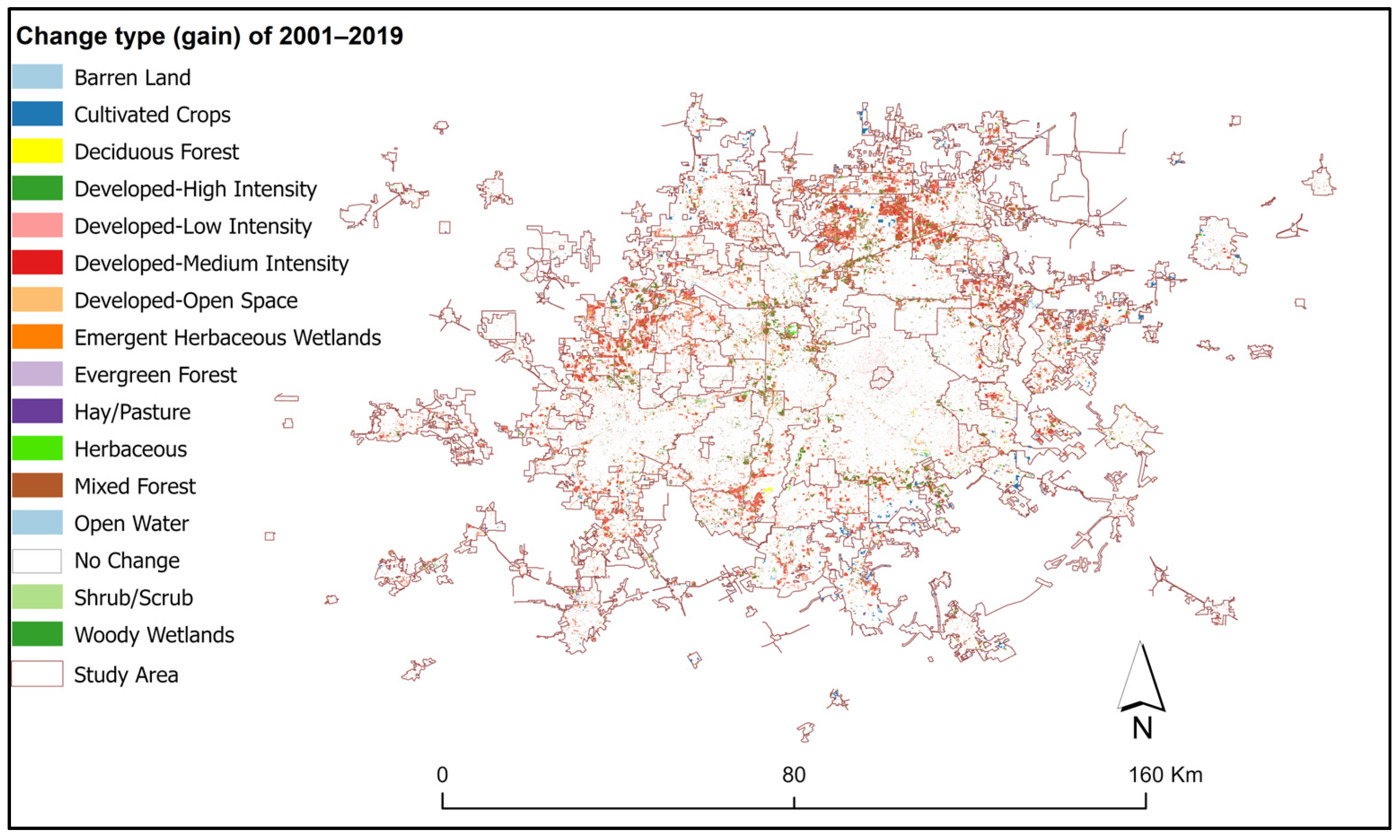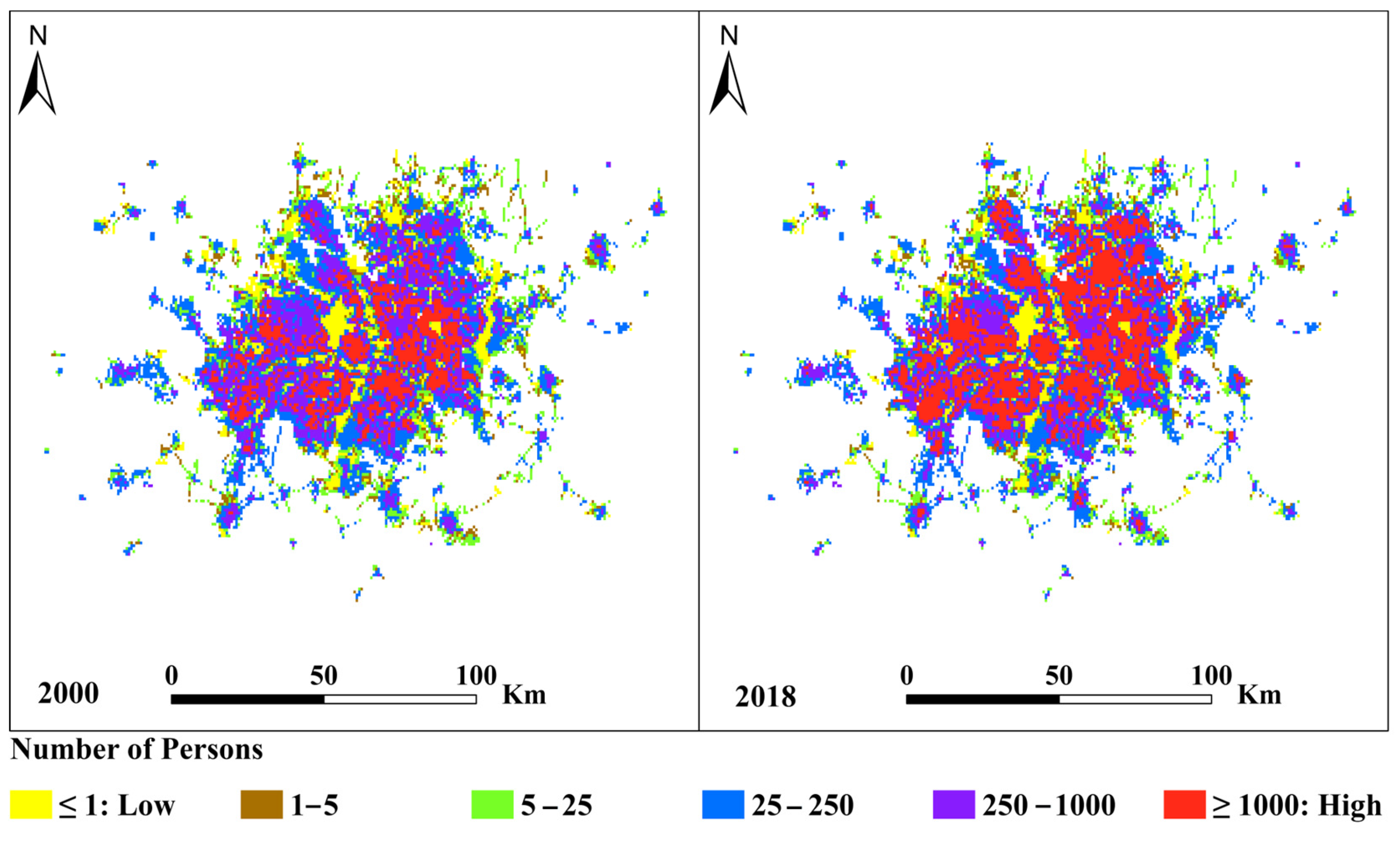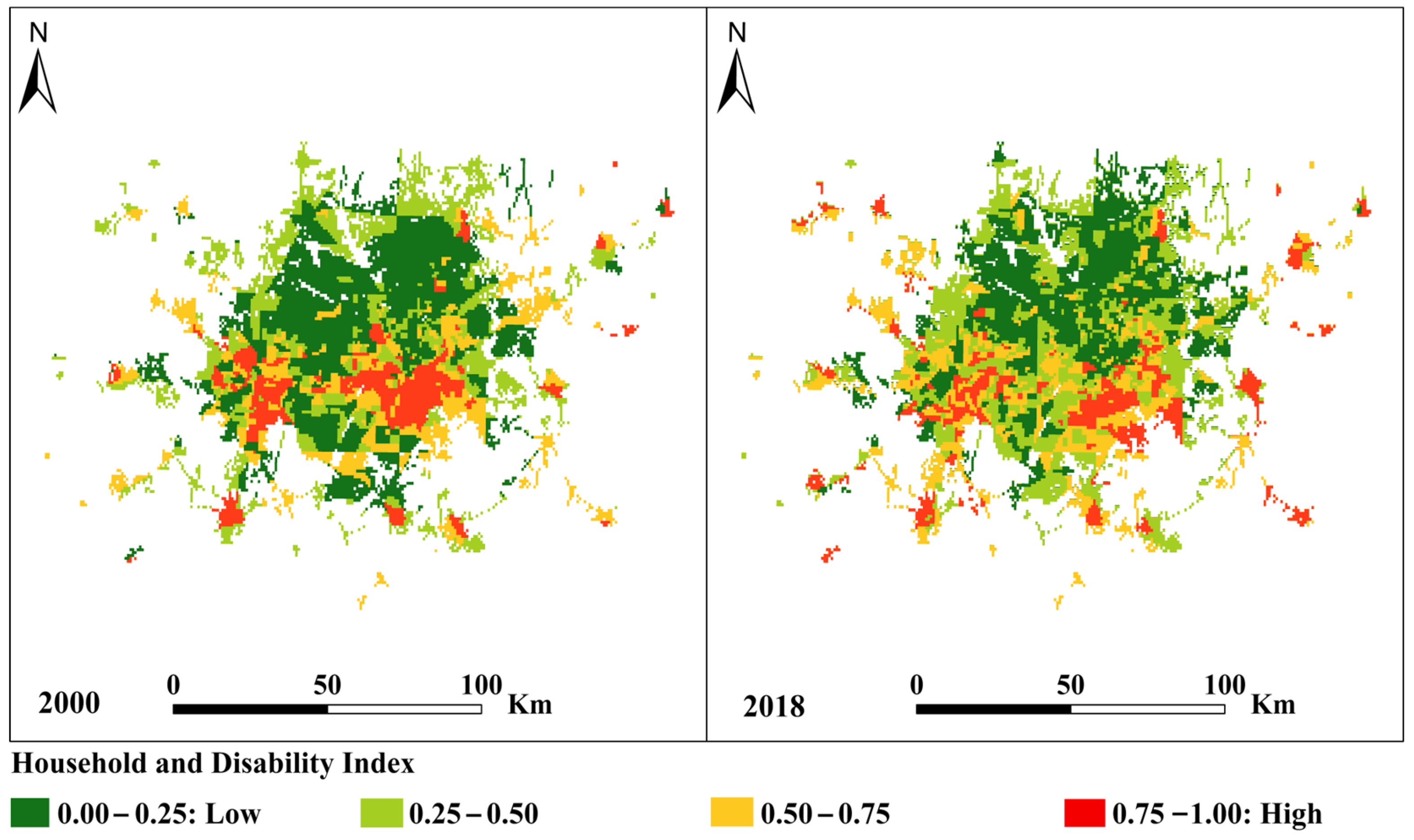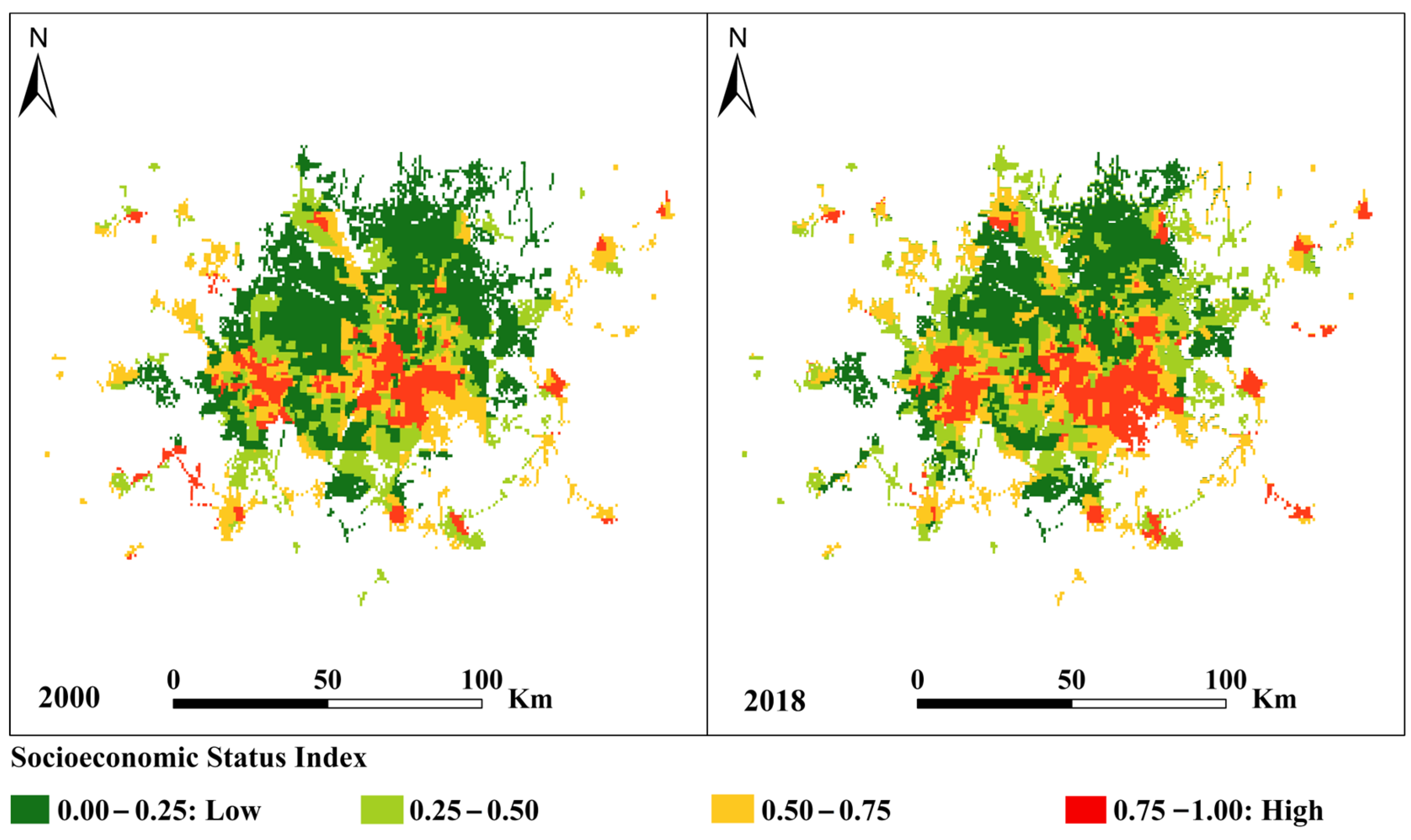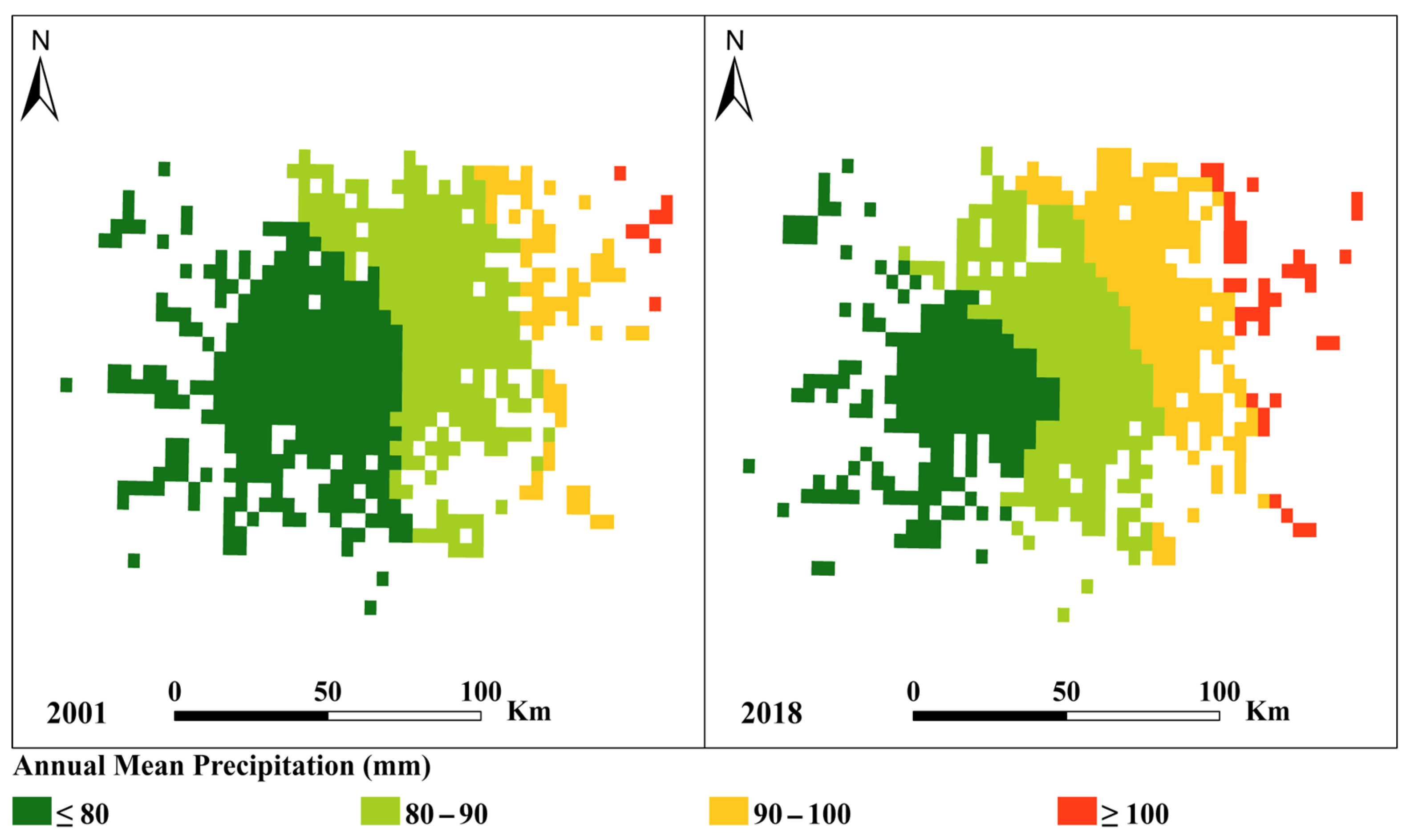1. Introduction
Land-Cover and Land-Use Change (LCLUC) is a global phenomenon that presents serious challenges to the sustainability of natural ecosystems and their services [
1,
2,
3], particularly in coupled human–environment systems [
4,
5,
6]. Because LCLUC affects the structure, diversity, and function of ecosystems by altering nutrient cycling [
7], habitat fragmentation [
8], loss of native biodiversity [
9], and changing hydrologic regimes [
10], understanding the drivers of LCLUC is critical for developing and implementing strategies that can improve and manage the ecological consequences of LCLUC [
3,
11,
12]. Although there is a wide range of mechanisms influencing LCLUC, the majority of LCLUC occurring around the world is the result of human activity, climate change, or a combination of both [
2,
12]. Early theoretical studies from the 18th and 19th centuries on population pressure and human-induced land degradation laid the groundwork for understanding the socioeconomic and environmental drivers of LCLUC [
13,
14,
15].
1.1. Socioeconomic and Climatic Drivers of LCLUC
Previous studies [
2,
12] have shown that LCLUC is related to complex interactions between socioeconomic (e.g., population density) and climatic (e.g., temperature, precipitation) factors. However, Refs. [
16,
17,
18] revealed that the socioeconomic drivers of LCLUC were found to not be consistent over time. According to Ref. [
19], initial socioeconomic factors (such as population growth) influenced land cover changes, which in turn resulted in altered structural and functional landscape characteristics. Historical research, such as the work of Refs. [
20,
21] in the mid-20th century, emphasized the role of human activities in transforming landscapes long before quantitative assessments were possible. All these studies also confirm that the most significant socioeconomic factors are connected to socioeconomic status, population, housing, and transportation. Regarding climate, Ref. [
22] found that specific combinations of climatic and socioeconomic factors were related to LCLUC, specifically those related to monthly or annual mean temperature and precipitation.
The combination of socioeconomic and climatic drivers makes effective and sustainable management of LCLUC difficult because socioeconomic factors behave differently than climatic factors at different temporal and spatial scales [
2,
12,
23]. Not all climate-related changes are easily detectable and manageable [
24]. Typically, LCLUC attributed to climatic factors (e.g., temperature, precipitation) is slower and more subtle [
25], whereas LCLUC caused by socioeconomic factors (e.g., population growth) is frequently rapid [
12]. As a result, it is critical to investigate the relationship between LCLUC and its driving factors to quickly expose the impact of human activities on the environment [
3]. Early environmental determinists such as Ref. [
26] also explored the influence of climate on land-use patterns, setting the stage for modern empirical studies.
1.2. Time Series of Remote Sensing Datasets
A rich legacy of spatial information from remote sensing (RS) and geographic information system (GIS) data is available at an appropriate spatial and temporal resolution to investigate socioeconomic and climatic covariates of LCLUC [
19,
27,
28,
29,
30]. Previous research has extensively utilized long-term datasets, such as Landsat imagery dating back to the 1970s, to assess the relationship between LCLUC and its driving factors. These studies have provided valuable insights into the persistence of changes over time. However, there remains a need for analyses that fully understand the temporal dynamics of LCLUC [
2,
31].
One of the most widely used datasets for LCLUC analysis in the United States of America (USA) is the National Land Cover Database (NLCD). The NLCD is the result of over 20 years of development and integration of time series of national land cover data by the Multi-Resolution Land Characteristics (MRLC) Consortium in the United States (U.S.). The MRLC Consortium is a bottom-up e-government initiative that provides digital land cover and ancillary data for the U.S. Since 2001, the MRLC has been providing Landsat-based, digitally produced, continental-scale data suitable for examining trends for a variety of land cover themes such as forest, urban, and impervious cover [
32,
33,
34,
35]. Many researchers have investigated and verified the NLCD’s quality for LCLUC studies [
31,
34,
35] or as an important input to socioeconomic studies [
36]. The overall thematic accuracy of NLCD is found to be high [
32]. Although such a time series of land cover datasets is valuable and can help monitor LCLUC, the lack of similar datasets for LCLUC drivers, especially some socioeconomic drivers, has always been challenging [
19]. In recent years, the Socioeconomic Data and Applications Center (SEDAC) has developed and made publicly available time series of remote sensing (RS) datasets with high spatial resolution for socioeconomic variables.
The SEDAC, a Data Center in NASA’s Earth Observing System Data and Information System (EOSDIS), hosted by the Center for International Earth Science Information Network (CIESIN) at Columbia University, has developed gridded socioeconomic datasets (e.g., socioeconomic status, housing type, transportation, social vulnerability) that can be used for mapping and spatial modeling, especially in comparative studies with other land cover datasets. Several researchers have used the SEDAC grids to study the dynamics of multi-decade socioecological change [
37] or the spatial distribution of racial diversity [
36]. Socioeconomic data with high spatial resolution are a valuable resource for addressing a wide range of critical issues, including measuring human pressure on the environment [
27] or environmental impact on the population [
38,
39]. Despite the fine spatial and temporal resolution of local and regional-scale socioeconomic data, only recently have these data become publicly accessible due to their high processing costs [
36,
37]. Gridded SEDAC data include information about housing and transportation, household and disability, socioeconomic status, and overall social vulnerability, which is defined as the degree to which a household or community suffers or may suffer from one or more socioeconomic issues such as poverty, unemployment, educational attainment, linguistic isolation, or the percentage of income spent on housing [
40,
41] at the household level [
37,
42].
Finally, high spatial resolution gridded global climate data, WorldClim, has been developed from downscaled Climatic Research Unit (CRU) Time-Series (TS) version 4.03 [
43] by the CRU, University of East Anglia, and corrected for bias with WorldClim 2.1 [
44]. The Worldclim 1.4 climate dataset is based on the interpolation of point observations from meteorological stations, which regionalizes monthly observational data of precipitation and temperature using a thin plate smoothing interpolation algorithm and latitude, longitude, and elevation as statistical predictor variables [
45]. Previous studies [
46,
47] have noted that the WorldClim remotely sensed temperature and precipitation data improve species distribution modeling and are suitable for ecological modeling studies, though the assessment of freely available WorldClim datasets, their computation methods, coherent limitations, and potential inaccuracies remain largely out of focus [
48].
1.3. Objectives
Despite the existence of these freely available remotely sensed LCLU, socioeconomic, and climate data, no studies have investigated the relationships between LCLUC and their drivers, particularly in large urban areas. This study aimed to assess the relationship of LCLUC with socioeconomic and climatic drivers based on correlation and multiple regression models to demonstrate that RS-derived datasets of LCLUC correspond to changes in socioeconomic and climatic factors in a rapidly urbanizing area.
4. Discussion
This study sought to identify LCLUC and changes in the context of socioeconomic and climatic drivers by utilizing a publicly available time series of RS datasets in one of the largest and most populated metropolitan areas (DFW) in the U.S. We found that growing socioeconomic pressures in this urbanized area coupled with on-going climate change have affected LCLUC, much to the diminishment of vegetated area, resulting in rapid global environmental change [
13]. Addressing these threats will support sustainable land management, which will significantly enhance the achievement of sustainable development goals. The spatial analysis of LCLUC highlights key patterns across the study area. Specifically, our results indicate that LCLUCs are not evenly distributed but rather exhibit distinct spatial patterns driven by underlying socioeconomic and climatic factors. For example, areas experiencing high urbanization and economic activity show greater LCLUCs, while regions with lower development pressures exhibit relatively stable land cover trends. The spatial patterns of temperature changes also suggest the presence of urban heat island effects, particularly in highly developed areas. These spatial insights provide a deeper understanding of the complex interactions between LCLUC, socioeconomic factors, and climate.
Our findings that LCLUC, socioeconomic, and climatic variables are correlated in line with recent studies examining these correlations on various regional to global scales [
2,
3,
12,
56,
57,
58]. This is consistent with the findings of Ref. [
58], which found that 60% of all LCLUC is caused by direct human-related factors and 40% by indirect causes such as climate change. Similarly, Ref. [
2] confirmed that socioeconomic factors are closely associated with changes in LCLU status. As a result, areas experiencing high intensity in terms of socioeconomic factors, such as high demands for housing and transportation or a higher rate of household or socioeconomic status, are at a high risk of LCLUC. Our spatial analysis further reveals that the most significant LCLUC transformations have occurred in the peripheral urban areas, particularly in zones with rapid residential and commercial expansion. This suggests that spatially targeted policies may be necessary to manage land development sustainably. However, the low regression coefficients observed in our study may be justifiable given the relatively short analysis period, the variability in LCLU during this time, and the limited sample size. In addition, other socioeconomic (e.g., GDP) and climatic (e.g., annual temperature) factors may also be important or more directly associated with LCLUC, for which we lacked gridded observations to include in our study. Given the importance of gridded observations in analyzing LCLUC, future studies should integrate historical gridded LCLU datasets, which are now widely available through various international sources. Incorporating these datasets will enhance the precision of LCLUC assessments and strengthen predictive modeling in this field.
Our study found that, of all studied socioeconomic factors, population change had a negative relationship with LCLUC. This opposes the common perception that population change and LCLUC should be positively correlated, as well as the findings of previous studies [
2,
59]. Although overall population numbers are often positively related to LCLUC, some research indicates that this overall relationship depends on a variety of factors (e.g., land settlement policies, and market forces). In other words, the effects of population change on LCLUC must be understood in the context of other drivers of LCLUC, indicating that population changes can affect LCLUC differently in different regions [
60]. This negative relationship between LCLUC and population changes in our study may be due to the heterogeneous effects of human activities on LCLUC, as previously demonstrated by Ref. [
12]. A heterogeneous and opposing direction of change pattern between LCLU and population was observed in the study area, indicating that a high changing rate of population occurred in areas close to the center of DFW and places far away from the central areas. However, more areas had LCLUCs far away from the central parts of DFW. Previous studies have revealed that most human activities take place close to metropolitan centers because of the convenience of access to markets and agricultural inputs [
61,
62]. Our spatial analysis suggests that this negative relationship may be influenced by differential land use dynamics within the study area. For example, areas with high population growth near the DFW metropolitan center may not exhibit large-scale LCLUC because of pre-existing urban infrastructure, whereas more extensive LCLUCs are observed in suburban and exurban areas undergoing rapid development. This highlights the importance of spatially contextualizing the relationship between population change and LCLUC.
We also found no correlation between LCLUC and SVI change. While previous studies [
63,
64] have indicated that socioeconomic vulnerability change and land cover indicators could be related to one another in natural ecosystems (e.g., rangelands), it seems that no such relationship exists between them in our study area. Our study’s results differ from their findings, possibly because the scale, complexity of the socioeconomic setting, and land use type of an area, whether it is a natural ecosystem or built-up land, can determine the relationship between LCLUC and its driving forces [
16]. In addition, the SEDAC’s social vulnerability is calculated using only a few variables, possibly missing important socioeconomic elements. According to Ref. [
63], social vulnerability alone has little to no direct connection with LCLUC. Social and economic vulnerability, when examined as socioeconomic vulnerability, can have a stronger correlation with LCLUC than either social or economic vulnerability alone. Socioeconomic vulnerability can act as a catalyst for LCLUC rather than its primary cause. According to Refs. [
65,
66], LCLUC tends to increase along with the increase in socioeconomic vulnerability if there is a high level of socioeconomic activity in an area. High socioeconomic activity levels are indicators of how dependent a community is on natural resources [
16,
67]. However, our spatial analysis further showed that areas with higher social vulnerability did not necessarily exhibit corresponding LCLUC trends. This suggests that other localized factors, such as zoning policies or economic diversification, may mitigate the expected impact of social vulnerability on land use change. This could explain why this study’s results differ from those of previous studies. Currently, the only major natural resources affecting direct economic activity in DFW are water and petroleum extraction from hydraulic fracturing [
68], both of which are unlikely to affect appreciable areas of land cover and use.
Of the climate variables, such as monthly average minimum temperature and mean precipitation change, these were found to be negatively correlated with LCLUC. This is consistent with previous research [
2,
16,
61]. This could be because most land use systems need certain temperature and precipitation conditions. High temperatures and low precipitation, for example, might well relate to drier conditions that are inappropriate for some land use types, including inhabited areas [
68,
69]. However, this study only considered the monthly precipitation and temperature values for two discrete years, 2001 and 2018. However, based on historical temperature values from DFW dating to 1899, average annual temperatures have been increasing by 0.1 °C per decade (
https://www.weather.gov/fwd/dmotemp) (accessed on 15 August 2023).
Finally, this study demonstrated that the remote sensing datasets from NASA, the MRLC Consortium, and WorldClim with high spatial resolution, which were used in this study, are essential for studying trends and causes of LCLUC. However, LCLUC drivers have been widely perceived using data obtained through social surveys or field studies [
70,
71]. Social surveys and field studies are simple to conduct but time- and money-consuming, and they are unlikely to be derived directly from remote sensing. Future studies should continue to use such datasets in assessing LCLUC, incorporating more detailed socioeconomic data, such as those from federal census information, and an expanded set and temporal sampling of climatic information. Additionally, future research should further integrate spatial analysis techniques to better understand the geographic variations of LCLUC and its drivers at finer scales.
5. Conclusions
To the best of our knowledge, this is the first study to assess the relationship between LCLUC and its socioeconomic and climatic drivers using a time series of RS-gridded datasets of agencies such as NASA in an important metropolitan area such as DFW. We concluded that, firstly, LCLUC is driven by a combination of both socioeconomic and climatic drivers. Secondly, LCLUC was negatively affected by changes in population, monthly average minimum temperature, and precipitation, whereas it was positively affected by changes in housing and transportation, household and disability status, and socioeconomic status. Finally, we concluded that the remote sensing-gridded products from NASA, the MRLC Consortium, and WorldClim could offer significant and spatially specific information in addressing socioeconomic and climatic factors affecting LCLUC. These freely available datasets may be used to save time and money when dealing with the LCLUC phenomenon around the world. The methodology used in this study is transferable to other regions, particularly other regions of the conterminous United States because gridded datasets for most of the socioeconomic and climatic factors with a spatial and temporal resolution are available from the agencies mentioned in this study (e.g., NASA’s SEDAC, WorldClim) that can be used in conjunction with national or global LCLUC datasets to study potential relationships between them. Additionally, several international studies, including those conducted by Chinese scholars, have applied various spatial and statistical models (e.g., random forest, regression tree, logistic regression model) to analyze LCLUC patterns. Incorporating findings from these studies can help improve the robustness of LCLUC assessments and provide broader insights into how different modeling approaches perform across various geographic regions. Future research should integrate such methodologies to strengthen comparative analyses and enhance predictive modeling of LCLUC at regional, national, and global scales before generalizing this study’s findings.
